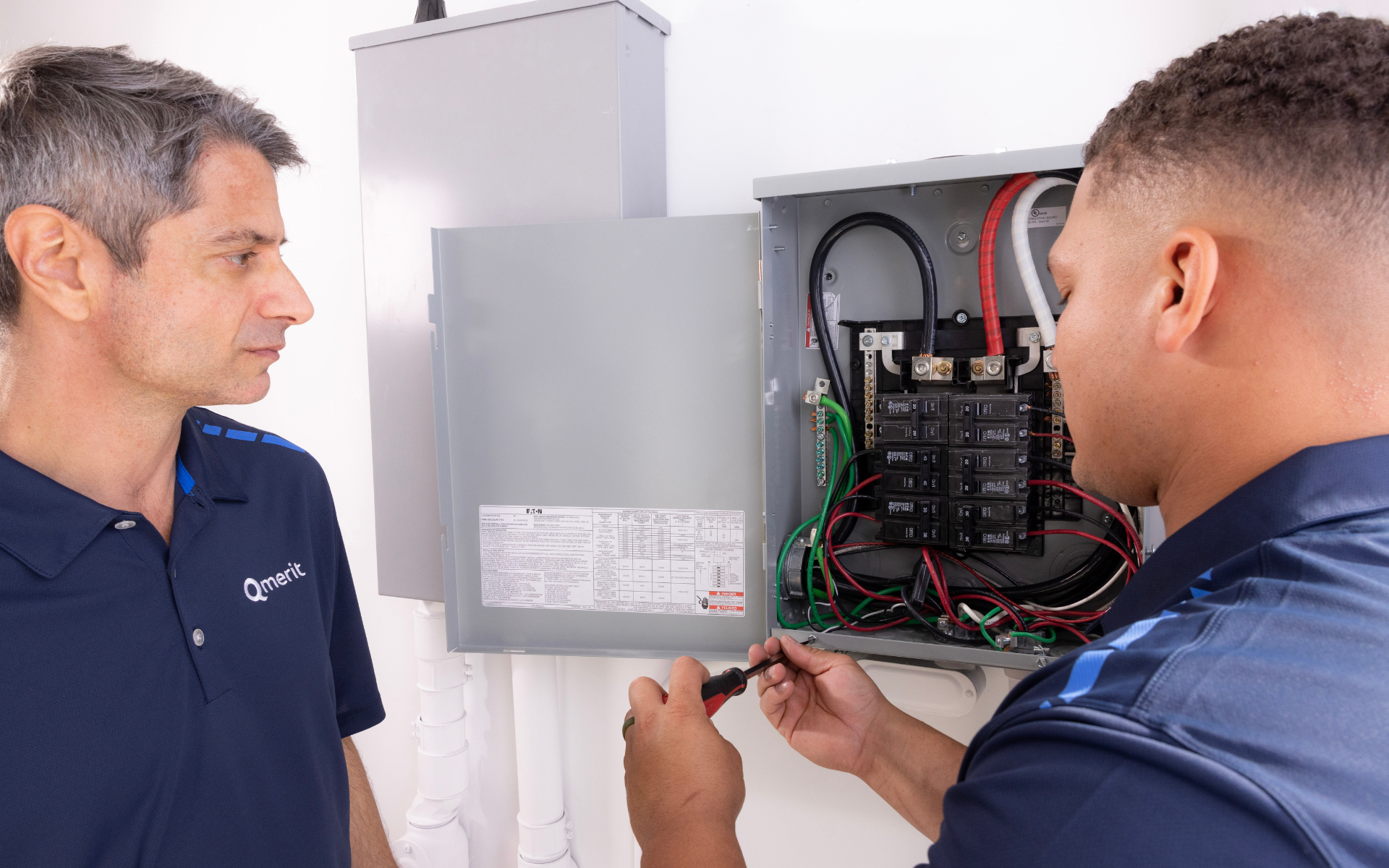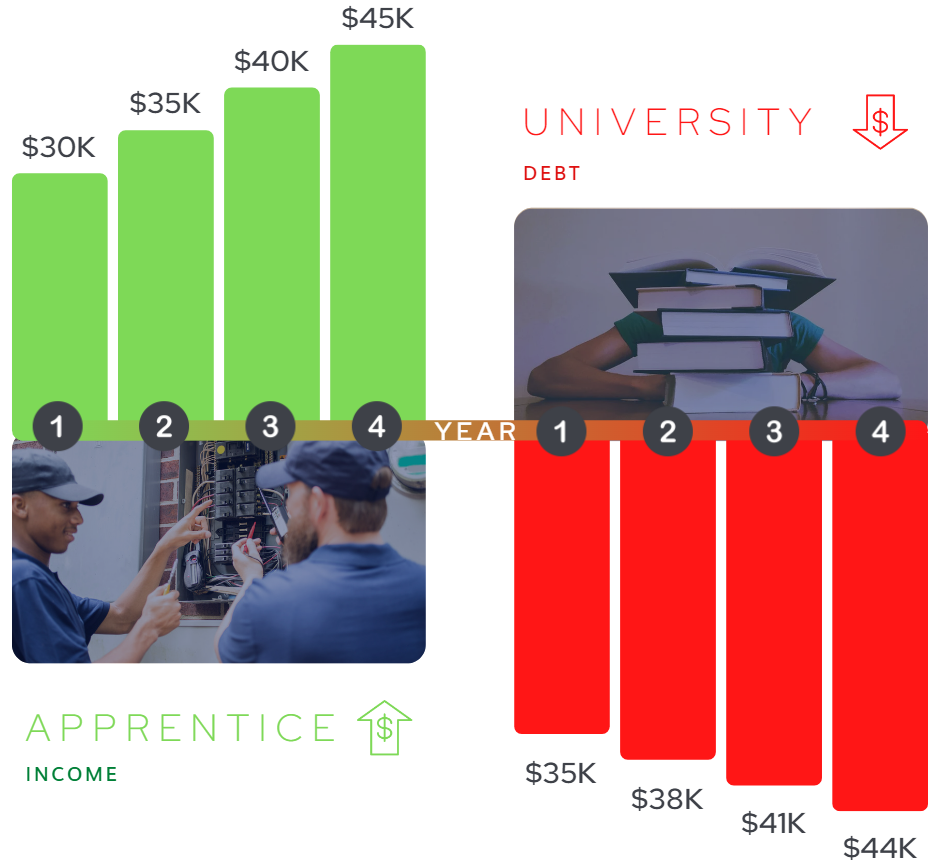Finding a Solution to the Current Electrician Shortage

6 Min. Read
Similar to many current economic issues, the electrician shortage is the result of a mismatch between supply and demand. Over the past 20 years, there have not been enough people entering the industry as experienced electricians are retiring, leading to a shortage in the supply of qualified electrical workers. The timing of which is being exacerbated by the stratospheric demand for electricians to meet the continually growing electricity needs of the nation is greater than ever. This gap will only widen with the proliferation of electrification technologies such as electric vehicle charging, battery storage, load management, panel upgrades, and other renewable energy product integration requirements.
From a big-picture perspective, there are three main forces driving the electrician shortage.
1. Experienced Electricians are Retiring at a Higher Rate
One of the main reasons behind the electrician shortage is the issue of experienced electricians leaving the industry at increased rates. While many of these retirements are a part of the normal cycle of employment, some are premature departures from traditional retirement timelines.
The COVID-19 pandemic accelerated retirement timelines for the Baby Boomer generation across all industries. Pew Research reported that the percentage of retired people over 55 increased in both 2020 and 2021.
On the positive side, the trend of early retirement will likely not continue at the same pace we are presently experiencing. In all age groups over age 55, the BLS (Bureau of Labor Statistics) projects that more people will be working in 2030 than in 2020.
This does not completely solve the problem as all Baby Boomers will be aged 65 or older by 2030. Since Baby Boomers represent such a substantial portion of the population, their absence from the skilled building trades workforce will be felt more deeply than previous generations.
2. Not Enough New Apprentice Electricians are Entering the Industry
Electricians leaving the industry would not be as great of an issue if new electricians were entering into the workforce in high enough numbers to replace them. Unfortunately, we do not currently have that kind of pipeline in place. In addition, it takes four years or 8,000 hours of hands-on work to become a Journeymen Electrician. This requirement dampens interest in our field and suppresses enthusiasm to meet the increasing demand.
Another reason is the inability to attract younger workers into the building trades. Only 16.7% of high school and college students say they want to work in construction — compared to 76.5% who want to work in technology.
Instead of attending a trade school or finding an apprenticeship, young adults are enrolling in two- or four-year colleges and universities. Members of Gen Z, the generation behind Millennials that is now entering the workforce, are more likely to enroll in college than any previous generation.
Gen Z workers also value flexible hours and remote work, and those accommodations are not always possible given job site and customer scheduling requirements.
3. Demand for Electricians Continues to Increase
Evening the score between the number of current retirements and new hires is not a viable solution, either. We need more new electricians than the number leaving.
Electrical work is a growing field. According to the U.S. Bureau of Labor Statistics, electrician jobs are expected to grow by 9.1% from 2020 to 2030. This is higher than the 7.7% growth rate projected for all occupations.
The increase in demand is driven by an increase in devices, buildings, and vehicles that rely on electricity. The total electricity consumption in the U.S. was expected to grow by 1.4% from 2021 to 2022; however, initial demand estimates in 2022 are showing an increase of 2.6%. Given this trajectory, the growth rate that the Bureau of Labor Statistics is forecasting could be as high as 25% by 2030.
People are using more electricity than before, and more electricians are needed to install and maintain these electrical systems.
Electrification Can Power Up Jobs in America with the Right Student Engagement
It all starts with developing the workforce. Traditionally contractors find electricians through job boards, family referrals, and trade schools. This approach is not relatable at scale to address the new dynamic of an aging workforce and the loss of 5% of our electricians yearly. According to the Association of Building Contractors, we add 3% net new electricians per year on average. This approach is not sustainable with the increasing demand we are seeing.
It is imperative that our industry starts from a grassroots level by starting to educate our middle school and high school students:
- Start by engaging with counselors at middle schools and high schools to attend career days and present the opportunities that becoming an electrician provides. Offer presentations that counter the stereotypes associated with construction.
- Present real-world images of the type of work electricians do, examples of sustainability, success stories of your electricians, and consider sharing your personal journey to becoming a successful business owner. Put these students in the picture.
- Highlight some of the key benefits of becoming an electrician, including the avoidance of student-loan debt and the likelihood of earning good pay immediately with annual wage increases thereafter. There is also an easy path to becoming a business owner given that electrical contract work can be done as a small business owner with relatively low start-up costs.
- Establish onsite career open house days, where students can visit your operation to see what electricians do and talk to your staff.
- Try to establish a trades program within your local high schools to begin teaching students these skills and establish a professional connection while they are still in school.
Discussion Points for Career Day or Outreach Initiatives
- Highlight “No debt.” The average college education costs roughly $25,707 per year totaling $120,828 over 4 years. In addition, it will typically be 4 years before a graduate is able to work full-time gaining experience in their selected field. An apprentice will typically earn more than $114,300 in that same period of time.
- The opportunity to become licensed and start your own business. The construction industry is the most entrepreneurial business segment in the U.S.
- Demonstrate the technologies that they will be working with, from tech tools to systems that are automating the world we live in.
- Electrical work is not just manual labor, but computer and technologically based.
- The job security provided by becoming an electrician ensures that you will always have career options. AI, robotics, etc. cannot replace the hands-on requirements associated with diverse complex electrical installations and solutions.
- Show pictures of the newest automation devices, such as EV Chargers, battery storage systems, digital smart panels, home automation, and renewable energy systems.
- Lastly, highlight how their work makes a difference to society and leaves a positive impact on the world.
An Investment in the Workforce is an Investment in Your Business
As a contractor, if you do not contribute to the challenge of developing interest in your field to attract new talent, then you may inadvertently contribute to the forces working to choke off the pipeline we need for business and career growth. Consider making recruiting, community engagement, and training a formal part of your business plans. We all know there are costs to workforce development; however, that may pale in comparison to the down-the-road costs of having to turn down customers or being too spread out and stressed out to deliver enjoyable, high-quality service, which is not why any of us became electricians.
In essence, by being proactive today, we can work to avoid making challenging, reactive decisions in the future.
Qmerit Can Help
At Qmerit, we help customers transition to sustainable electric solutions by leveraging our network of local contractors. As North America’s most trusted installer for electrification technologies, Qmerit is proud to support our customers and our electrical contractors.
Qmerit has been working hard to help resolve the ongoing electrician shortage, and our workforce development team can help you maximize recruiting best practices to acquire apprentice and journeymen electricians, while training existing employees on all the latest electrification technologies.
Seize the moment. Get the training and resources you need to become a leader in your local market. Contact Qmerit today to open up a new customer base for your electrical contracting company and expand your hiring practices to prepare for a bright future with electrification.

